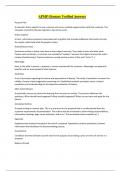Exam (elaborations)
APMP Glossary Verified Answers
- Course
- Institution
APMP Glossary Verified Answers Account Plan A sales plan that is specific to one customer and covers multiple opportunities with that customer. The timespan covered by the plan typically is two to five years. Action Caption A short, informative statement associated with a graphic that pro...
[Show more]



